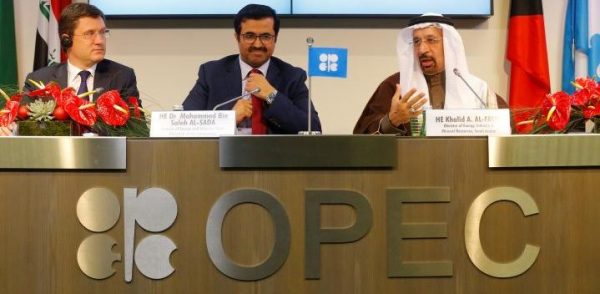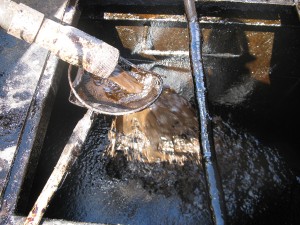Saudis, Russia to diverge on speed of oil output cuts – Kemp

Russia’s Energy Minister Alexander Novak, OPEC President Qatar’s Energy Minister Mohammed bin Saleh al-Sada and Saudi Arabia’s energy minister Khalid al-Falih (L-R) address a news conference after a meeting of the Organization of the Petroleum Exporting Countries (OPEC) in Vienna, Austria, December 10, 2016. REUTERS/Heinz-Peter Bader
By John Kemp
LONDON (Reuters) – OPEC and non-OPEC members have pledged to cut their combined oil production by an average of just over 1.7 million barrels per day (bpd) in the first six months of 2017.
Saudi Arabia and its Gulf allies are expected to implement most of their cuts immediately, but other producers both within and outside the Organization of the Petroleum Exporting Countries are likely to phase in the reductions gradually.
The collective cut should increase progressively over the first half of 2017 and have its biggest impact on the supply-demand balance from the second quarter onwards.
Market tightening should be felt at the start of summer as output cuts are fully phased in, U.S. refineries ramp up for the driving season, and crude combustion in Saudi Arabia and Iraq starts to rise.
Compounding this effect, continued underlying growth in oil consumption in both OECD and non-OECD economies during the first six months should also help progressively tighten the supply-demand balance.
OPEC and non-OPEC members also have given themselves the option to extend the cuts for a further six months depending on prevailing market conditions.
If they decide on an extension, the supply-demand balance could tighten even more quickly in the second half of 2017.
CONTANGO VANISHES
Most traders expect market rebalancing to be backloaded, with futures prices trading in contango in the first half of 2017 but then moving to level or backwardation in the second half.
The structure of prices is consistent with a gradual phase-in of cuts during the first semester and their extension into the second (“Brent curve signals oil tanks will start emptying in second half of 2017”, Reuters, Dec. 21).
But the different pace of production cuts for different countries increases the risk of non-compliance, especially towards the end of the first half and in the second half of 2017.
If the agreement succeeds in raising prices and drawing down excess inventories, some countries may not deliver all the cuts they have promised.
Compliance is likely to be greatest by Saudi Arabia and its allies at the start of the period, and least by countries such as Russia towards the end.
PRODUCTION OPTIONS
In most cases, a new well will produce its highest daily output in the first days, weeks and months after completion, when the natural pressure in the reservoir is greatest.
Daily production tends to decline progressively thereafter as pressure falls (“Petroleum geology, exploration, drilling and production”, Hyne, 2001).
Production rates can be described by a decline curve (“The decline and ultimate production of oil wells”, Beal, 1919).
Oil producers employ several methods to offset production declines from existing wells and maintain field output.
New wells can be drilled to replace declining production from existing holes (either within the same reservoir or from a new one).
Surface pumps or downhole pumps can be employed to raise more oil from old wells by providing artificial lift to replace natural field pressure.
And production from old wells can be stimulated by injecting water, gas and chemicals into the producing formation to sweep more of the remaining oil towards the well bores and help it flow more easily.
Most producing countries have a mix of old and new wells, of varying vintages and at various stages of decline, some on artificial lift or being stimulated by secondary and tertiary recovery techniques.
Producers therefore have a menu of options for cutting output by shutting in or choking back existing wells, discontinuing artificial lift, ceasing to drill new holes, or scaling back secondary and tertiary recovery.
Hinting at the importance of these options, non-OPEC countries have committed “to reduce their respective oil production, voluntarily or through managed decline, in accordance with an accelerated schedule”, OPEC said.
HOW TO CUT OUTPUT
Saudi Arabia and its allies are likely to cut production by shutting in or possibly choking back output from older wells in older fields.
Saudi Arabia shut in more than 1,000 wells during the last round of OPEC cuts in 2008/9, according to an analysis of well data (“Annual Statistical Bulletin”, OPEC, 2016).
Most of those were less productive (and presumably older) because the number of wells still in production dropped much more than the decline in actual output.
Production per active well rose sharply, indicating older and less productive wells were shut while newer and more productive ones continued to flow.
Much of Saudi Arabia’s famed output flexibility comes from the kingdom’s ability to shut in or reopen hundreds of older wells in older fields.
Shutting old fields and wells makes economic sense because it can extend their lives and increase the amount of oil ultimately recovered from them.
Conversely, Saudi Arabia can boost output by bringing old wells back into production, but at the cost of lower ultimate recovery (“Cost of pump-at-will oil policy spurred Saudi OPEC U-turn”, Reuters, Dec. 15).
So this time around Saudi Arabia is likely to meet most of its output-cutting commitment by resting older wells and older fields, which can be implemented fairly quickly.
Kuwait and the United Arab Emirates are likely to employ a similar strategy that will deliver production cuts quickly.
Saudi Arabia has already implemented its cuts fully, a Gulf source familiar with Saudi oil policy said on Thursday (“Saudi Arabia cut oil output in Jan to 10.058 million bpd”, Reuters, Jan. 5).
ARCTIC AND SUB-ARCTIC
Onshore and shallow offshore wells in Saudi Arabia and its Gulf allies are relatively straightforward to close, but shutting in wells in other countries will be more difficult.
Russia, in particular, has warned it cannot close some existing wells in Arctic and sub-Arctic regions without risking irreversible damage.
Oil comes up from deep underground at high temperatures and helps prevent damage to wells and field equipment in the frozen north.
The problem of shutting in existing wells is obviously greatest during the northern winter, when it affects the maximum number of wells.
Russia is therefore relying on natural decline and a reduction in new well drilling to meet its commitments under the deal.
Relying on field declines rather than shutting existing wells also makes it easier for Russia to secure the assent of its myriad private producers.
BACKLOADED CUTS
In recognition of these problems, Russia and other non-OPEC producers secured the right to phase in cuts and average them over the entire six-month period.
Officials in Moscow have repeatedly said cuts will be phased in gradually, meaning Russia is likely to deliver its deepest reductions only at the end of the six months.
Backloading creates a temptation to cheat, however, since the full extent of any non-compliance will become evident only in the second half of 2017.
If the supply-demand balance has started to tighten by that stage, the market may be able to absorb a level of non-compliance without so much impact on prices.
However, if OPEC and non-OPEC deliver their promised cuts, including backloading, and extend them into the second half of the year, oil inventories could shrink rapidly later in 2017.










